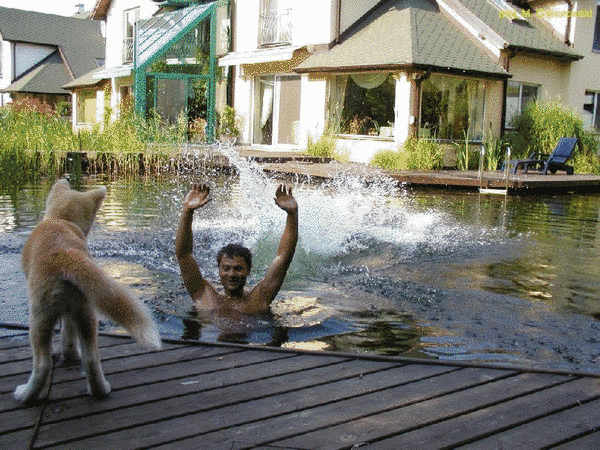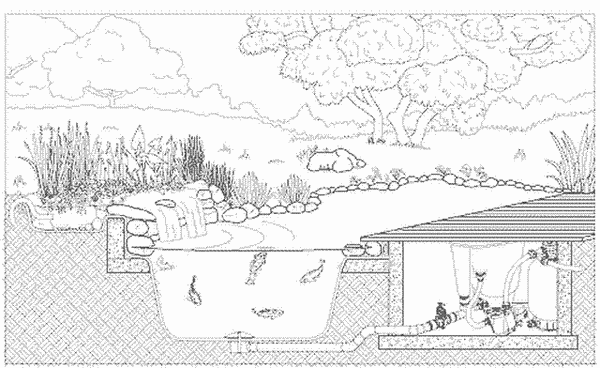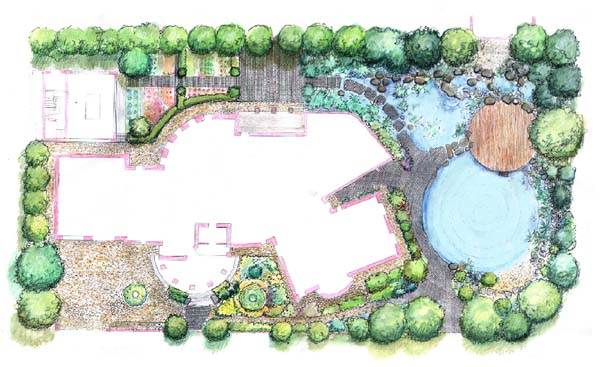
Who doesn’t like splashing in sun-warmed, clean water? Swimming ponds equipped with plant eco filters are one of most popular garden features in the last few years.
AQUA SYSTEM designs and constructs modern and functional swimming ponds in private and public structures. In all our projects we only use natural water filtrating systems based on natural water purifying minerals.
Naturally purified water, so pleasant for bathing, doesn’t cause allergy and complies with all strictest H&S requirements. If there is sauna in the pond ground surface, you can use it all round year or eventually the pond can be transformed into a gorgeous ice rink in winter.

What is the idea behind a Swimming Pond?
Definition is seemingly simple: a swimming pond is a big, tight reservoir filled with water which is conditioned through mechanical and biological self-cleaning processes. However it is not a standard pond with plants on the ground surface. It’s a more complicated engineering construction resembling a sewage treatment plant, an eco-alternative for swimming pools where all organic life is removed by applying chemical agents.
All self cleaning processes are intensified in a swimming pool. All natural vegetative – mineral deposits filtrate the water. Their parameters are specifically designed for each reservoir. Those deposits reduce volume of phosphate and nitrogen causing growth of algae and undesirable bacteria. All plants are selected to consume as many of these biological compounds as possible. Some of them destroy phenols, others block growth of algae, and others disinfect the water.
First swimming ponds were created in the middle of the 80s of 20th century in Germany and Austria. The idea was accepted and there are dozens of thousands of similar small and large constructions throughout Western Europe. They are found in hotel complexes, hostels, B&B’s and private gardens. Even public swimming pools currently being disinfected with chloride are being modernized and equipped with bio filters. What’s more interesting, it’s much cheaper to build a swimming pond rather than a classic swimming pool. Exploitation costs are lower and maintenance requires less work!.
How does it look?
Swimming ponds can look like natural lakes with soft shore lines or may have straight and geometric shapes. Projects depend on the character of the garden. If your plot is huge you can have an extensive swimming pond with a natural looking large plant zone. If your plot is rather small and is located close to the terrace then its design needs to be carefully adapted to the building; proportions and materials need to be taken into consideration.

Large Swimming Ponds.
The oldest type of swimming ponds are almost devoid of technology – they are large extensive ponds – modeled on natural reservoirs. They look wild and link the garden with the landscape. The swimming zone takes up around 30% of the total area, and all the rest – up to 70% – is planted with rushes and under-water plants and creates a purifying zone.
If an area of 60m2 is allocated to free swimming, at least 200m2 has to be designed for an large extensive pond. Water circulation between the regenerative zone and swimming zone carries on thanks to wind and temperature difference between warm shallow zones and deep zones. Water circulation can be improved with cascading which also speeds up all purifying processes. Small pump circulating up to 30% of pond water per day allows reducing the area of purifying zone up to 10-15%.
To prevent sludge settlement in the swimming zone, boggy zones are separated with underwater divisions (such as concrete walls). This type of pond is designed for natural environment fans who do not mind newts or frogs, and in spring also algae (before water plants grow up). The sludge from the deeper part of the pond can be removed with underwater vacuum without a need to let out the water.
Small Swimming Ponds.
Vegetable filters are the heart of a water purifying system in a small swimming pond but additionally advanced technology can be used. These ponds are additionally equipped with efficient pumps which circulate water (improve skimmers efficiency) and support water exchange between boggy filters and swimming zone. A special pond bottom outflows a pipe off polluted water to the settling tank and mechanical filters.
A small pond requires precise, professional design – calculation of hydraulic elements volume to assure optimal water flow, selection of proper pumps and skimmers, planning filters installation. Chemical water analysis is followed by accurate selection of boggy filters (capacity and mineral composition). Filtrating deposits have to be composed in accurate proportions of rocks and minerals regulating water hardness and pH as well as phosphate and nitrates absorbents.
In some cases additional mechanic filtrating chambers are built. Mineral deposits need to be changed or activated from time to time. Filters are designed not to eliminate animal plankton which plays so important a role in self-cleaning processes.
Boggy zones in small ponds do not have to be space- linked with swimming zone. Vegetable filter connected with pipes may be fitted separately. This technique not only allows improved water quality but also improved care and most importantly – reduction of regenerative plant zones. Intensive ponds can even be located on a small plot. For 60m2 of swimming zone approx 40m2 of purifying zone is required. Powerful pumps consume more energy but water flow can be regulated depending on how often the swimming zone is in use.
We strongly recommend you contact us to find out more of what we offer. All enquires are warmly welcome!
[totop]
